Back in black: the curious rise of cheap, licensed music T-shirts in Australia
A loving ode to the humble band T-shirt – a cross-generational beacon of fandom that has been uniting music fans worldwide for decades.
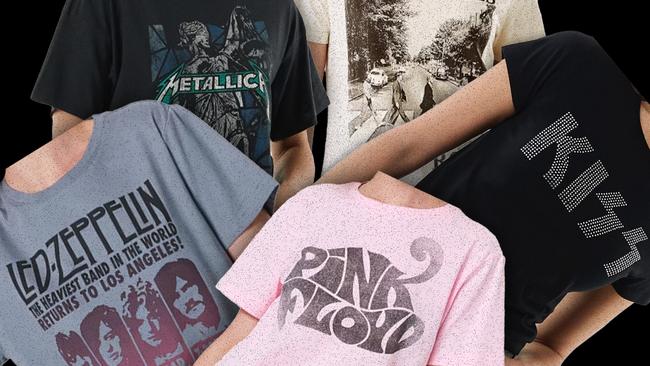
As a teenager, one of my most prized possessions was an item of clothing bought far from my home town, where such things were simply not available for sale.
I know because I scoured every possible retail location in Bundaberg, the regional Queensland city where I grew up, and came back empty-handed.
The black T-shirt featured a four-letter word, written in lower case: Tool, a quartet from California whose music is painted in dark tones and arranged in unusual time signatures.
In my adolescence, few things thrilled me as much as this band’s progressive metal sound, and I was determined to find a shirt that wordlessly advertised my fandom to all and sundry.
Problem was, the department stores – the likes of Target, Kmart and Big W – did not stock music merch of any description.
The biggest record store in town was part of the Sanity chain, and it contained a small collection of music T-shirt designs – mostly sized XL, far too big for my skinny frame – that rarely featured new stock of any sort, let alone anything branded Tool.
In the early 2000s, Bundaberg was a desert as far as music merch retail opportunities were concerned. In the parlance of my youth, this fact sucked, big time.
Occasional trips to Brisbane to visit family, then, became intertwined with the capital city’s independent record shops, particularly one named Skinny’s, which stocked a bounty of T-shirts of all shapes, sizes, colours and genres. To an avid music freak like me, it was heaven; the only problem was the limited contents of my bank account.
It was there that I found that beloved T-shirt, which cost $30 in 2002. It was something I pulled on only sparingly, on special occasions, rather than wearing it until its fibres became loose and tattered.
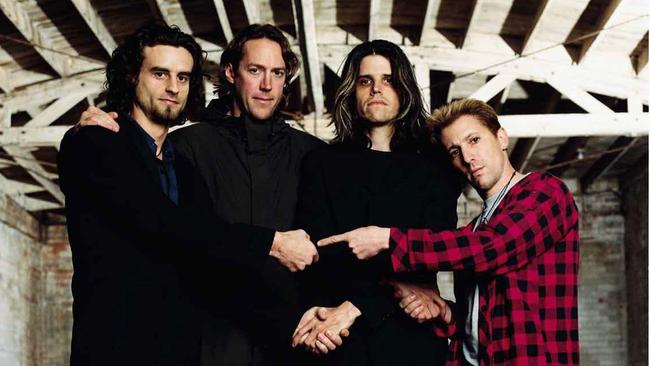
When I entered the workforce at about age 15, washing dishes at Sizzler, a good chunk of my disposable income was funnelled into music merch – either from those hotly anticipated visits to Skinny’s, or later, by ordering from overseas sellers with my parents’ credit card, when online shopping was in its somewhat dodgy nascence.
Music is central to my identity, so much so that attempting self-analysis on such a thing is like asking a human heart why it pumps blood around a body. Some things are simply built for a purpose. Then and now, my heart beats to the rhythm of a love for notes, chords, melodies and grooves.
But if you’d asked my younger self why I felt compelled to purchase and wear a shirt advertising Tool – or Powderfinger, or A Perfect Circle, or John Butler Trio, or System of a Down, or any of my other fascinations of that era – I’d have probably answered in terms of opposition.
In that time-honoured, binary way of adolescent thinking, I was exploring the boundaries of defining myself through a prism of in-groups and out-groups; perceived “cool” and “uncool”; what was hot and what was not.
I saw the act of wearing a band’s T-shirt purely as an association of fandom for the music itself, rather than a branding exercise, or simply because someone liked the look of a particular logo, name or image.
Only “true fans” invested in a band’s catalogue, I thought, should bother to pull on an item of clothing advertising Nirvana, or The Ramones, or The Beatles, or any other artist noteworthy enough to attract the attention of mass-market screen printers.
It took me a long time to work out what now seems so obvious: I was wrong.
This year, I’ve spent more hours than is reasonable stalking the clothing racks of department stores great and small, from Tamworth to Adelaide, Melbourne to Hobart, and across the suburban shopping centres of Brisbane.
The creeping trend I’ve found there is one that has surprised and fascinated me, and would have thrilled my younger self. That retail desert of my youth? It’s now an oasis. Affordable music merchandise is in abundance.
Walk into any Kmart, Big W or Target store nationwide and you’ll find a surprisingly sizeable stock of officially licensed band T-shirts, usually including some or all of the following: AC/DC, Guns N’ Roses, Metallica, The Rolling Stones, KISS, Pink Floyd and Led Zeppelin.
At these stores, the average cost for a T-shirt is $15 to $20 – a remarkably low price point when compared to the $60 that fans were queuing in their thousands to spend at the merch desks set up near stadiums when Guns N’ Roses toured here a year ago.
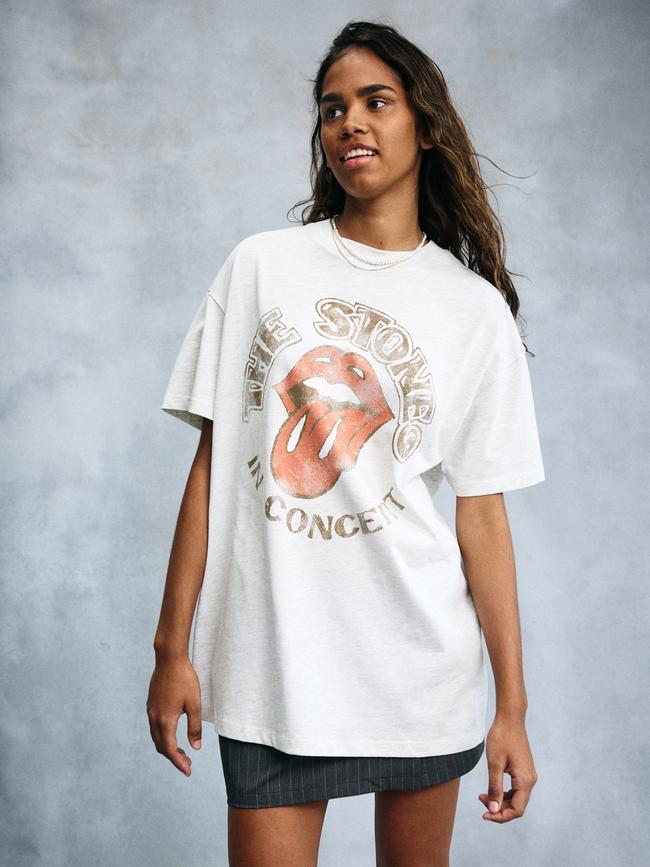

Sometimes there’s even a few other licensed items for sale, such as Rolling Stones board shorts ($25), Pink Floyd cap and socks gift packs ($12), AC/DC matching pyjamas ($30), Beastie Boys caps ($15) or infant-sized Sweet Child O’ Mine singlets ($12).
In my travels, I’ve spotted branded gear advertising Gorillaz, Run DMC, The Who, Elton John, Blondie, Foo Fighters and Motley Crue. Most of these graphic designs simply sport the artist’s logo, and perhaps a picture of the band or singer in action.
A few are rooted in historical dates: the Use Your Illusion tour of 1991, say, or KISS’ Spirit of ‘76, or Bowie’s 1974 world tour – right down to bizarrely specific events, such as the poster design for Led Zeppelin’s November 20, 1971 gig at Wembley, where the name of the band’s manager Peter Grant appears above his client. (“All seats 75p” reads a note at bottom of poster; oh, how times have changed.)
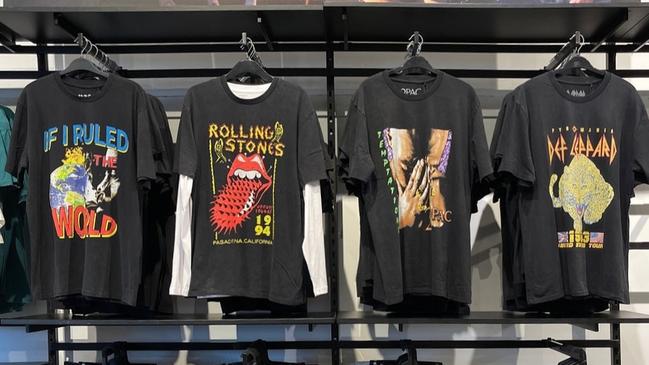
This mass-marketing of some of the world’s most popular recording artists is a modern phenomenon, and one that is all but unrecognisable to those who lived through the early years of rock ’n’ roll.
In a 2017 interview with Billboard magazine, US merch pioneer Dell Furano said, “In the 70s, it was not cool selling merchandise, so we had to be careful. Groups would say, ‘OK, you can sell, but don’t embarrass us. Stand in a corner’.”
More recently, his company Epic Rights represented artists including Madonna, John Lennon, David Bowie and Britney Spears. In 2019, Furano sold the business to Bravado, the merchandising and brand management arm of music market leader Universal.
Furano died of cancer two years later, but he had lived long enough to watch the sector grow from an afterthought to a multibillion-dollar global industry wherein licensed clothing sales have become a central pillar of artists’ income.
In 2017, when he was asked why the basic band T-shirt remained the strongest seller among music fans, Furano replied, “They loved it in the beginning and love it as much today … The black concert tee has reigned as king for over 40 years. It has become not only a fashion statement, but also a collector’s item and a multi-generational shared experience.”
Graeme Jack can vouch for the sentiment expressed by the late merch kingpin, because he’s watched it unfold inside his home. His daughters, aged 13 and 10, have spent the past six years awash in music clothing because their dad is Bravado’s head of Asia Pacific.
“My kids wear merchandise to bed,” Jack tells Review. “They wear adult-sized T-shirts, and they wear it as a nightie. They come out in the morning, and they’ll be in a Def Leppard or a Black Sabbath – and that’s so much cooler than them coming out with little bunny pyjamas,” he says with a laugh. “It’s a real ‘proud dad’ moment for me.”
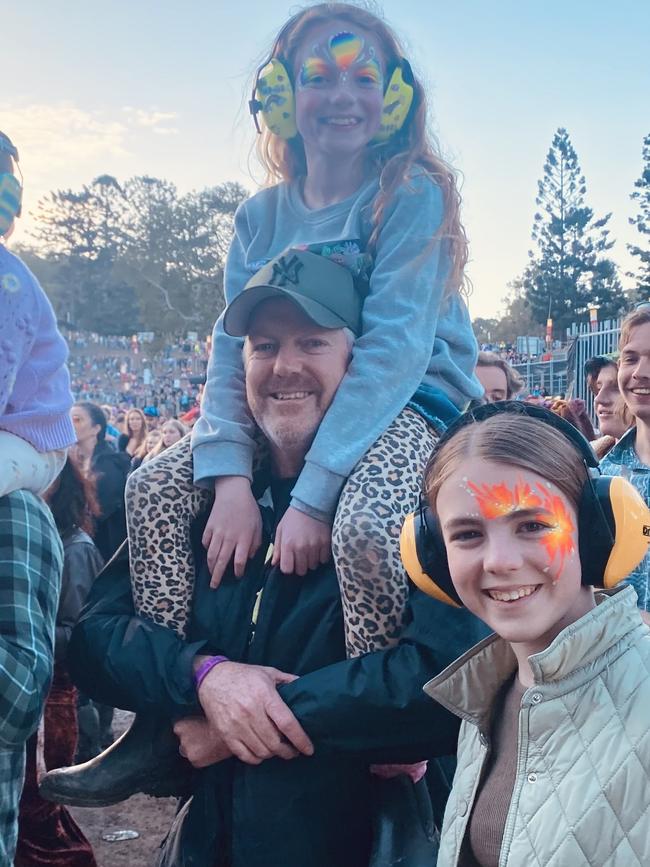
Globally, Bravado represents about 190 artists: its headline acts, so to speak, include The Rolling Stones, Guns N’ Roses, Queen, Justin Bieber, Blackpink, Ariana Grande, Spice Girls, Tupac and Billie Eilish. Among Australian bands, its growing roster includes Cold Chisel, INXS, Midnight Oil, Mental as Anything and Hoodoo Gurus.
“When I was growing up, 70 per cent of everything in market was bootleg, and the artists never got the payments or got to control their own brands,” says Jack, 52. “(The bootleggers) were basically lifting designs, putting them on a T-shirt and profiteering off it.”
Conversely, he says, Bravado’s whole reputation “is staked on the fact that we work so closely with the artists; they can trust what we’re doing, and they have the right to say yes or no to absolutely everything that we’re doing”.
“Therefore, we become an extension of the artist, and that’s what you’re seeing when you’re buying product: it’s the real deal,” he says. “It’s not a cheap counterfeit knock-off, where somebody isn’t thinking about how that product came into being. We never look at ourselves as a licensing partner that goes, ‘We’re just going to try to make as much money out of your licence as possible.’”
From speaking with Jack, I learn that I’ve been stalking the bottom end of a competitive national market where Bravado and its rivals ply their trade.
As well as department stores such as Kmart, Big W and Target, Bravado sends graphic tees to clothing stores such as Culture Kings, General Pants Co, Universal Store, Jay Jays and Cotton On while offering a mix of designs and price points.

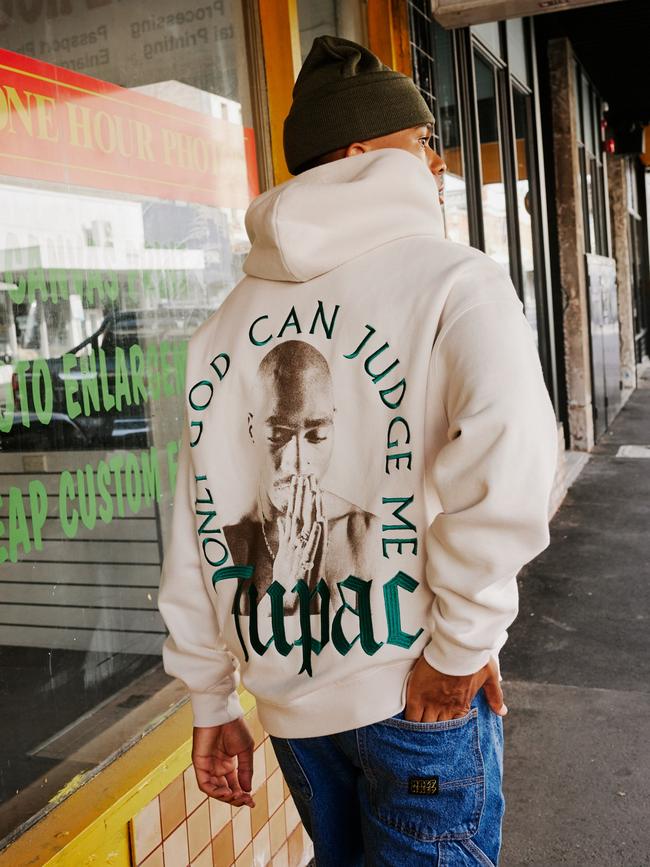
When I ask about the curious phenomenon of selling newly printed designs from decades-old concerts, he replies, “Nine times out of 10, the kid wants to have something that looks like it’s been found in their parents’ wardrobe and pulled out. It’s about our desire to have ‘official heritage’ stuff. That’s what it is; that’s what I want,” he says with a laugh. “I wish my parents went to some stuff in the 70s – I’d love it!”
In recent years, my teenage obsession has turned on itself in an unexpected manner. When I moved out of my parents’ home, I left behind a bunch of T-shirts that no longer spoke to me, my tastes – both fashion and musical – having since moved on.
At some point, though, my father Paul opened my closet and liked some of what he saw – so much so that some days, as he goes about his business, he might be the only retiree in southeast Queensland proudly wearing a T-shirt advertising the oddball US alt-metal band System of a Down.
When I tell this to Jack, he replies, “Do you see what that represents? He could be wearing Country Road, or he could be wearing any other brand – but look at the statement he makes when he walks into a room with that, and look at your association with it. That doesn’t happen very often, right? That’s what makes it really special. Music is for everybody; it’s universal, and it should be celebrated more.”
On a Sunday in early December, as I walked the grounds of a music festival held at the Brisbane Showgrounds, I found myself lapsing into a nostalgic frame of mind.
Perhaps it was triggered by the fact that the very first band I’d ever seen perform live – Perth rock band Jebediah, at the Bundaberg Showgrounds in 2000 – was also booked to play there.
Within that 23-year span in my concertgoing career, my ears had heard many hundreds of concerts. But as well as touring the sounds emanating from five stages on that summer’s day, my eyes fell into a familiar habit of scanning thousands of T-shirts as they passed me by.
What was I looking for? Nothing in particular; just looking.
At a cellular level, these were my people – music lovers – and since my fascination formed as a child, I’ve been drawn to the decisions that we make about clothing to adorn our person for a day, particularly one spent among 30,000 fellow fanatics.
Festivals present an opportunity for a unique cultural collision, and within the fences that surrounded the final leg of the three-city Good Things tour, for 10 or so hours, you were unlikely to find a greater concentration of band clothing in all of Australia.
It was a kaleidoscopic vision of shirts new and old; treasured museum pieces from long-ago tours worn especially on days like this, as well as a mountain of freshly unboxed fabric sold inside the gates and immediately pulled onto torsos.
A curious minority partook in the age-old tradition of homemade shirts worn especially for the event: “Honk if you love Fred Durst,” read one scrawled in handwritten letters and worn by a skinny youngster, referring to the vocalist for US nu-metal band Limp Bizkit, which was among the top-billed acts.
Before I joined the throng, I chose a favourite black Deftones T-shirt, bought impulsively almost a decade ago, after I had watched the Californian alternative metal quintet slay a crowd of thousands while headlining a Big Day Out side-stage.
Is there a greater compliment you can pay an artist than rushing to the merch desk immediately after their set to exchange your money for clothing bearing their name?
A small but potent incident of fandom, sparked by an adoration that was transferred on to screen-printed cotton and kept proudly in our closets for special occasions, or perhaps just a trip to the local supermarket.
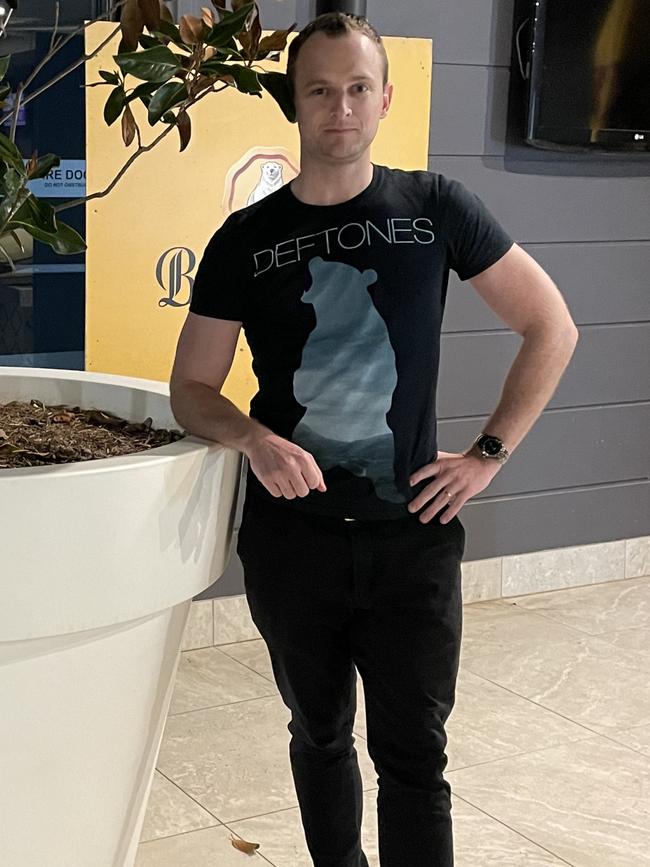
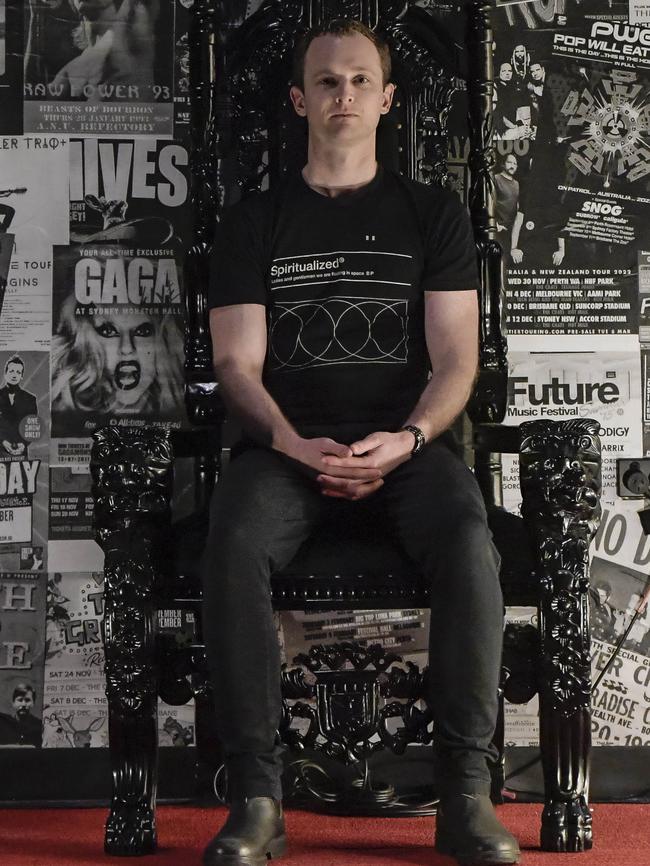
My friend Mackenzie, meanwhile, joined me sporting a black Halsey top, acquired at Falls Festival 2016 when she saw the US pop artist play to a small afternoon crowd while touring her debut album, Badlands – a fashion flex from an early adopter who was tuned into Halsey’s music long before the millions that followed.
There’s a particular pride that swells the ego when someone spots your shirt at a concert, does a double-take, and makes a point of complimenting you on your choice. Mackenzie told me she had one of these recently at an All Time Low gig: a girl was profusely crying when the house lights flicked back on, and as she walked past, the emotional stranger grabbed her, stopped crying and said, “2013 tour?”, motioning to their matching tees.
I’ve stopped to pose for photos with random blokes at festivals when we realised we were T-shirt twins, and both lit up like fireworks at the unexpected sight.
Late in the afternoon at Good Things, I had another of those moments of recognition. As we passed one another in the urinal queue, a sweaty, sunburnt, bearded man clocked the bold-face name on my chest, set above an image of a powerful bear standing on its hind legs. “DEFTONES!” he roared, meeting my eyes and grinning.
In that instant, time and space collapsed. Forming an in-group of two, we were united in a love for the singer’s ethereal melodies situated amid the guitarist’s jagged, distorted tones. Even if we had absolutely nothing else in common with one another, briefly, we were brothers.
That exchange of mutual appreciation was a thunderclap between two strangers, but it was echoed and multiplied by the tens of thousands of music fans spread across the festival grounds and beyond.
Acres of fabric, stitched onto our sweaty bodies, formed a tapestry of passion prompted by artists whose music moves us to mosh, headbang, sing, dance, listen and think. Taken together, these are the threads that bind us.






To join the conversation, please log in. Don't have an account? Register
Join the conversation, you are commenting as Logout